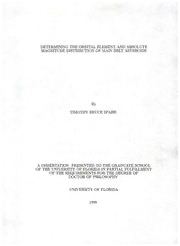Table Of ContentDETERMININGTHEORBITALELEMENTANDABSOLUTE
MAGNITUDEDISTRIBUTIONOFMAINBELTASTEROIDS
By
TIMOTHYBRUCESPAHR
ADISSERTATION PRESENTEDTOTHEGRADUATESCHOOL
OFTHEUNIVERSITYOFFLORIDAINPARTIALFULFILLMENT
OFTHEREQUIREMENTSFORTHEDEGREEOF
DOCTOROFPHILOSOPHY
UNIVERSITYOFFLORIDA
1998
Dedicatedtomyparents.
ACKNOWLEDGEMENTS
Therearetoomanypeoplethathavebeenessentialtothisworktoacknowl-
edgethemall,butIwilltrytoincludethemostinstrumental. BrianMarsdenhasbeen
continuallysupportive. GarethWilliamswasalwaysreadytoprovideephemeridesfor
newBSSobjects,anditseemedhewasalwaysconnectedtoacomputersomewhere.
CarolynandGeneShoemakerwerealwayshelpful,evenaftertheGreatCometCrash
hadthemcirclingtheglobetoattendmeetings. WithoutSteveLarson’shelp,assis-
tance,andsupport,therewouldhavebeennoBSS.MyfriendsDave,Jo,Tony,Kirk
andNicolekeptmesanebyforcingmetoplaycardsatleastonceaweek. Ithankmy
goodfriendandcolleague,CarlHergenrother,forputtingupwithmeduringlong,
tediousobservingrunswiththeSchmidt. FinallyIthankJoannaforhersupport,
herenthusiasm,andherheart.
m
TABLEOFCONTENTS
ACKNOWLEDGEMENTS
iii
ABSTRACT vi
CHAPTERS
1 INTRODUCTION 1
1.1 Reasons 1
1.2 HistoryandPastSurveys 3
1.3 OrbitalElements 5
1.4 StructureoftheAsteroidBelt 7
1.5 Contents 11
2 MDS,PLSANDSPACEWATCH 20
2.1 StartingPoint: TheMcDonaldAsteroidSurvey 20
2.2 ThePalomar-LeidenAsteroidSurvey 21
2.3 InclinationLimitationofthePLS 22
222...456 TTIshhmee0SPpraaoUcbselewefamutlcwhiQtuShaunFrtoviretcyyedatEcalcle?ntricity 222334
2.7 PLS,Spacewatch,andtheCatalogedAsteroidPopulation .... 25
3 THEBIGELOWSKYSURVEY 35
3.1 WhatistheBSS?WhoWeretheMainPlayers? 35
3.2 BackgroundandMotivation 36
3.3 GeneralInformation 37
3.4 GeneralDiscussion 40
4 DEBIASINGTHEPLS 47
4.1 HowDoesDebiasingWork? 47
4.2 HowtoCalculateP? 48
4.3 TheTBSMonte-CarloMethodforDetectionProbabilities .... 49
4.4 HowDoesPVaryforaStandardField? 51
4.5 ApplicationtothePLS 52
4.6 DeterminationofthePLSVMagnitudeEfficiency 52
4i.n7EaWchhyHthBeinPLSWillUnderestimatetheTrueNumbersofAsteroids 53
4.8 TheTrendwithLongitudeofPerihelion 54
IV
4.9 Results 54
4.10 Additional 56
5 DEBIASINGTHEBSS 74
5.1 Introduction 74
5.2 GeneratedObjectsandDetectionEfficiency 75
5.3 Results 77
5.4 GeneralTrendsintheRegiona=2.6-3.3AU 77
5.5 NewFamilies 78
6 WHEREISTHEBESTPLACETOLOOKFORCERTAINTYPESOF
ASTEROIDS? 86
6.1 TheGeneralConcept 86
6.2 QuantitativeStudy: EosandMariaFamilyAsteroids 86
7 SUMMARY 90
7.1 Conclusions 90
7.2 FutureWork 92
REFERENCES 95
BIOGRAPHICALSKETCH 97
v
AbstractofDissertation PresentedtotheGraduateSchool
oftheUniversityofFloridainPartialFulfillmentofthe
RequirementsfortheDegreeofDoctorofPhilosophy
DETERMININGTHEORBITALELEMENTANDABSOLUTE
MAGNITUDEDISTRIBUTIONOFMAINBELTASTEROIDS
By
TimothyBruceSpahr
May 1998
Chairman: Dr. StanleyDermott
MajorDepartment: Astronomy
Wepresentheretwogeneraltechniquestoremoveobservationalselectionef-
fects fromasteroidsurveys. When appliedtotwospecific asteroidsurveys, these
methodshave allowed thefirst computationofthe debiaseddistributionofaster-
oidalorbitalelementsandsizesforthefirsttime. Thefirstsurveywasconducted
in 1960. Advancesincomputinghaveallowedthedatatobere-analyzedusingan
existingcomputerprogramandgivenamuchmorerigorousstatisticaltreatment.
Thesurveywasconfinedtothenear-eclipticatopposition,thereforeitsusefulness
islimitedwithregardtohighlyinclinedorbits. Tocompensateforthislimitation,
weconductedourownsurveyaimedspecificallyathigh-inclinationobjects. Since
theseorbitsare,ingeneral,distributeddifferentlythanlower-inclinationorbits,re-
movingobservationalselectioneffectsrequiredcreatingastatisticaltechniqueusing
Monte-Carlotypesimulations.
vi
The results ofthis work show no evidence for differingslopes ofthe size-
frequencydistributionthroughouttheasteroidbelt,fromthehighlyinclinedHungaria-
typeasteroidsintheinneredgeofthebelt(1.8-2.0AU),totheouterbelt3-3.5AU).
Theslopesoftheabsolute-magnitudefrequencydistributions, beinglessthan0.5,
showthattheasteroidalsizedistributionissomewhatshallowerthanwhatwouldbe
predictedassumingtheasteroidstobeacollisionallyevolvedpopulationofbodies
withsize-independentimpactstrengths. Alsodeterminedareroughnumbersofas-
teroidsinthemaindynamicalfamiliesofEos, Maria,Themis, andKoronis,which
compriseasignificantfractionofthetotalnumberofobjectsinthemainbelt. This
workhasalsoresultedinthediscoveryofanewasteroiddynamicalfamily,andpos-
siblytwonewasteroidgroups.
Vll
H
CHAPTER1
INTRODUCTION
Scientistswhowishtoobtainusefulstatisticalinformationonalargepopula-
tionofobjectsarefacedwithtwochoices: observeandcatalogtheentirepopulation
orobservesomesmallersampleofthewholeandscalethesedatainsomemeaningful
andappropriatefashioninordertoobtaininformationaboutthewhole. Toextend
theresultsofasmall-scalesurveytothewholepopulationrequiressome debiasing
techniquetoremovetheobservationalselectioneffects. Thisispreciselytheprob-
lemfacingastronomersstudyingasteroids. Itisestimatedthatthereareatleast
1,000,000asteroidswithdiametersgreaterthanabout1km,yetthepresentdetected
populationcontainsonlyabout 50,000members. There have been manysurveys
aimedspecificallyatdiscoveringandcatalogingasteroidsoverthepast50years,but
veryfewhave attemptedtoremoveobservationalselectioneffectsandpredictthe
totalpopulationofasteroidsdowntoagivensize. Asaresult,wehaveobservational
completenessonobjectsdowntoonlyabout25km,orthoseobjectswithabsolute
magnitudes,H,lessthanabout11.0. ( istheVmagnitudeoftheasteroidatthe
mythicallocationof1AUfromboththeSunandtheEarthatzerophaseangle.)
Theaimofthisworkistointroducetwodebiasingmethodsandapplythemtotwo
differentasteroidsurveysinordertoobtainthebestestimateforthedistributionof
mainbeltasteroidorbitsandsizesforthefirsttime.
1.1 Reasons
Firstandforemost, thisThesisisan attempttogainabetterunderstand-
ingofthenumerousobservationalselectioneffectsthatinfluence asteroidsurveys.
1
2
Whilesomegeneraltrendsarealreadyknown,thissubjectislargelyunexplored. By
theconclusionofthisresearch, weshouldhaveasolidunderstandingofthemost
importantselectioneffectspresentinasteroidsurveys.
Perhapsthemostimportantreasonforthisworkistodeterminethemass-
frequencydistributionoftheasteroids.Themassdistributionisnotobtaineddirectly,
but indirectlyfrom the size distribution, or the absolute magnitude distribution.
Dohnanyi (1969) found that the mass distribution ofa set ofmutually colliding
bodies,allwithsize-independentimpactstrengths,couldbedescribedby:
f(m)dmocm~qdm (1.1)
with f(m) beingthe numberofobjectsin themassrangemtom -b dm and q,
theslopeindex, = 11/6forcollisionalequilibrium. Tocomparewiththeabsolute
magnitudedistribution,i.e.,aplotoflog(n)versusH,withnbeingtheincremental
(andnotthecumulative)numberinabinofH,theslopesarerelatedbythefollowing
equation:
q=\a+l C1-2)
whereaistheslopeoftheabsolutemagnitude-frequencydistribution. Inthecaseof
collisionalequilibrium,a=0.5forobjectswithsizeindependentimpactstrengths.
Anavaluesignificantlydifferentthan0.5,confirmingtheresultsofDurdaandDer-
mott (1997),wouldplaceconstraintsonthestrength-scalinglawforasteroidsand
perhapsprovideuswithcluestoasteroidalcompositionandstructure. Unfortunately,
ourobservationallycompleteset(thesetofasteroidsdowntoacertainsizethatwe
havediscoveredverynearlyeveryexistingmember)onlycontains2644membersand
extendsonlytoH=12.5intheinnerbelt,andH=11intheouterbelt. Without
debiasingtheasteroidbelttoH>13,ourobservationallycompletesetwillprovide
noinformationona(andhenceq)sincethetransitiontothecollisionallyevolved
3
portionoftheasteroidbeltoccursatH~ 13(seealsoDurdaandDermott1997).
Witha,orqinhand,wewillbeabletopredicttheamountofdustintheZodiacal
Cloudfromasteroidsalone.
Another important result to beobtained from this work will be the total
numberofasteroidsinthemainfamilies. Thiscaninturnbeused,alongwithq,to
predicttheamountofdustinjectedintotheZodiacalCloudfromthesemainfamilies.
Theorbitalelementdistributionandnumberdensity, particularlyforthose
objects near resonances, will allow us to get a direct estimate ofthe number of
objectsonunstableorbits,andthusanestimateofthenumberofobjectsrequiredto
replenishtheseareas. IftheexpectednumberofNear-EarthObjects (NEOs) from
this type ofanalysisis toosmall, it willindicate asignificant numberofextinct
cometsexistintheNEOpopulation.
High-inclinationasteroidsarealwaysundersampledbyeclipticsurveys. The
absolutemagnitudedistributionoftheseobjectswillbeofimportancetodetermine
whether ornot thesize distributionisdifferentthan that ofotherregions ofthe
asteroidbelt,asthesehigh-inclinationobjectscollidelessfrequentlythanotherob-
jects,butdosowithmuchhighermeanimpactvelocities. Becausetherearesofew
highinclinationobjectsintheobservationallycompleteset, asurveythatpresents
thedebiasedorbitalelementdistributionofthesehigh-inclinationobjectswllbeof
usesimplysothatwecan,forthefirsttime,viewtheorbitalelementdistributionof
theseobjects.
1.2 HistoryandPastSurveys
Surveyingforasteroidshastakenplaceonandofffornearly200years. In
September 1800 the infamous “Celestial Police” met to discuss searching for the
mythicalmissingplanetbetweenMarsandJupiter. These24astronomerschoseto
dividetheeclipticin15degreeswathes,andsearchedforthemissingplanetvisually.

